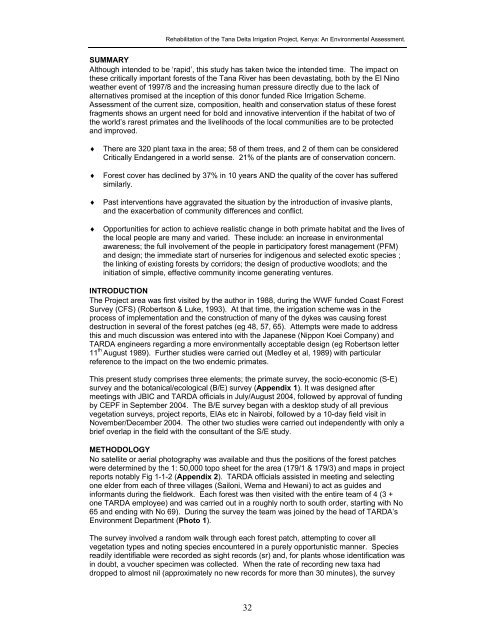Tana Delta Irrigation Project, Kenya: An Environmental Assessment
Tana Delta Irrigation Project, Kenya: An Environmental Assessment
Tana Delta Irrigation Project, Kenya: An Environmental Assessment
You also want an ePaper? Increase the reach of your titles
YUMPU automatically turns print PDFs into web optimized ePapers that Google loves.
Rehabilitation of the <strong>Tana</strong> <strong>Delta</strong> <strong>Irrigation</strong> <strong>Project</strong>, <strong>Kenya</strong>: <strong>An</strong> <strong>Environmental</strong> <strong>Assessment</strong>.<br />
SUMMARY<br />
Although intended to be ‘rapid’, this study has taken twice the intended time. The impact on<br />
these critically important forests of the <strong>Tana</strong> River has been devastating, both by the El Nino<br />
weather event of 1997/8 and the increasing human pressure directly due to the lack of<br />
alternatives promised at the inception of this donor funded Rice <strong>Irrigation</strong> Scheme.<br />
<strong>Assessment</strong> of the current size, composition, health and conservation status of these forest<br />
fragments shows an urgent need for bold and innovative intervention if the habitat of two of<br />
the world’s rarest primates and the livelihoods of the local communities are to be protected<br />
and improved.<br />
♦<br />
♦<br />
♦<br />
♦<br />
There are 320 plant taxa in the area; 58 of them trees, and 2 of them can be considered<br />
Critically Endangered in a world sense. 21% of the plants are of conservation concern.<br />
Forest cover has declined by 37% in 10 years AND the quality of the cover has suffered<br />
similarly.<br />
Past interventions have aggravated the situation by the introduction of invasive plants,<br />
and the exacerbation of community differences and conflict.<br />
Opportunities for action to achieve realistic change in both primate habitat and the lives of<br />
the local people are many and varied. These include: an increase in environmental<br />
awareness; the full involvement of the people in participatory forest management (PFM)<br />
and design; the immediate start of nurseries for indigenous and selected exotic species ;<br />
the linking of existing forests by corridors; the design of productive woodlots; and the<br />
initiation of simple, effective community income generating ventures.<br />
INTRODUCTION<br />
The <strong>Project</strong> area was first visited by the author in 1988, during the WWF funded Coast Forest<br />
Survey (CFS) (Robertson & Luke, 1993). At that time, the irrigation scheme was in the<br />
process of implementation and the construction of many of the dykes was causing forest<br />
destruction in several of the forest patches (eg 48, 57, 65). Attempts were made to address<br />
this and much discussion was entered into with the Japanese (Nippon Koei Company) and<br />
TARDA engineers regarding a more environmentally acceptable design (eg Robertson letter<br />
11 th August 1989). Further studies were carried out (Medley et al, 1989) with particular<br />
reference to the impact on the two endemic primates.<br />
This present study comprises three elements; the primate survey, the socio-economic (S-E)<br />
survey and the botanical/ecological (B/E) survey (Appendix 1). It was designed after<br />
meetings with JBIC and TARDA officials in July/August 2004, followed by approval of funding<br />
by CEPF in September 2004. The B/E survey began with a desktop study of all previous<br />
vegetation surveys, project reports, EIAs etc in Nairobi, followed by a 10-day field visit in<br />
November/December 2004. The other two studies were carried out independently with only a<br />
brief overlap in the field with the consultant of the S/E study.<br />
METHODOLOGY<br />
No satellite or aerial photography was available and thus the positions of the forest patches<br />
were determined by the 1: 50,000 topo sheet for the area (179/1 & 179/3) and maps in project<br />
reports notably Fig 1-1-2 (Appendix 2). TARDA officials assisted in meeting and selecting<br />
one elder from each of three villages (Sailoni, Wema and Hewani) to act as guides and<br />
informants during the fieldwork. Each forest was then visited with the entire team of 4 (3 +<br />
one TARDA employee) and was carried out in a roughly north to south order, starting with No<br />
65 and ending with No 69). During the survey the team was joined by the head of TARDA’s<br />
Environment Department (Photo 1).<br />
The survey involved a random walk through each forest patch, attempting to cover all<br />
vegetation types and noting species encountered in a purely opportunistic manner. Species<br />
readily identifiable were recorded as sight records (sr) and, for plants whose identification was<br />
in doubt, a voucher specimen was collected. When the rate of recording new taxa had<br />
dropped to almost nil (approximately no new records for more than 30 minutes), the survey<br />
32

















